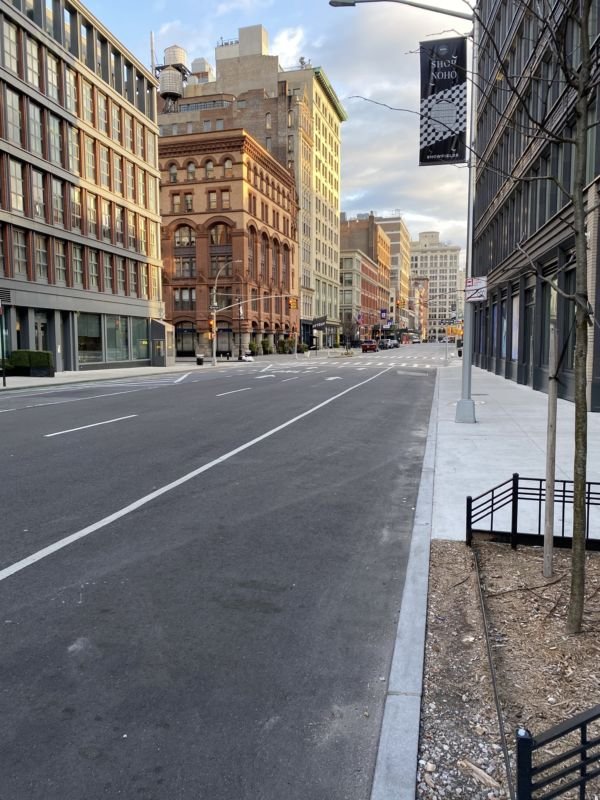Corona Time in SoHo
An empty street in NoHo. Photograph by Luigi Cazzaniga.
By Ilka Scobie | March 28. 2020
Art Critics on Emergency is a real-time collective diary by AICA-USA members about the impact of the COVID-19 pandemic on art critics, artists, arts institutions, art education, and the arts at large. AICA-USA members are invited to submit journalistic reflections and critical observations about this moment as it unfolds.
The press opening for the Whitney Museum’s exhibition, Agnes Pelton, Desert Transcendentalist on March 6 was one of my last days of quasi-normalcy. The delicate and mostly abstracted paintings were new to me and luminously soothing. Unmasked people chatted, nibbled on miniature pastries, and drank good coffee. We listened to curators’ speeches, wandered through the exhibition, and then dispersed into the rapidly emptying streets of Manhattan. In the following days I taught poetry at a wonderful public school on East 109th Street, The Young Scholars Talented and Gifted program. I told my principal on Friday that I would not be returning for the following week. Over the weekend, Mayor De Blasio finally closed the public school system.
That Friday, March 13th, on my way to the local Whole Foods I hit three neighborhood galleries: Eva Presenhuber, Salon 94, and Sperone Westwater. I had gone to the sparsely attended Presenhuber opening of Swiss artist Jean-Frederic Schnyder and I appreciated the second chance to bask in his quirkily beautiful salon style show. The works of Timothy Washington, a California artist associated with the Black Art movement, were on view at Salon 94, with totemic sculptures and graphics, while Richard Long commandeered Sperone with a site-specific mud work. The galleries were mostly empty. the staff, which warmly welcomed me, shared the same shell shock permeating the city. We all wished each other safety.
Installation view from Timothy Washington's exhibition Pucker Up, 2020. From salon94.com.
And that’s it. By the weekend, my upcoming poetry reading at La Mama was cancelled. The Purchase Order Department wasn’t answering my calls and it seemed like my recently submitted bills had been faxed into an abyss. A quickly and perfectly executed plywood blockade was erected on the plate glass front of an overpriced salumeria on my block. At 7am, the worker told me looting was expected, hence the barrier.
In my neighborhood wanderings, I ran into the painters Stanley Whitney and Marina Adams. Both looked dapper, sporting sunglasses against the early spring glare. We all have ties to Italy, and compared notes. Soncino, my husband’s hometown (where we have a family house and a great biennale takes place), is in the center of the Lombardian pandemic. My husband returned from Italy to New York in early February, and stressed the seriousness of the emerging epidemic. A few days later the first Italian cases were reported in the nearby town of Codogno. Stanley and Marina have a house in Emilia Romagna and were in constant communication with friends there. Forewarned by the Italian disaster, we chattered on the corner, still unmasked, but worried. I left, energized by the chance encounter and ensuing burst of community.
Union Square under quarantine. Photograph by Luigi Cazzaniga.
Now our loft feels quieter, the neighborhood has been deserted by those leaving the city. Despite generous offers from friends to shelter on the Long Island shore or in suburban Connecticut, I feel as safe as anyone can here in my own house. Crocuses are blooming on the fire escape and I just planted quick growing salad greens.
My inbox, flooded with virtual museum tours, gallery shows, and offers to participate in video poetry readings is somewhat intimidating. No cultural institutions remain open but there seems to be an abundance of web-based artistic offerings and inspiration. Friends in Berlin and London are in the same uncharted territory, self isolating to varying degrees.
Everyone I know is in some dimension of panic. My friends uptown in Harlem say street life is still lively, but downtown where I live it is almost free of pedestrian activity. Daily calls from Italy and a stream of Italian news on TV keeps tensions fairly high in my house. We have limited all social contact but welcome seeing people we know on the street. Soon I fear we will all be more confined and these unplanned meetings will no longer be possible.
Jean-Frédéric Schnyder, Studie 17, 1997, Oil on canvas. From presenhuber.com.
Everyone is wondering how smaller galleries will remain open, how artists will keep their studios functioning, and what will happen to the art world in light of political and financial unknowns. Art fairs have been digitized for collectors’ consumption. A conversation has begun about how the art world—let alone how the world at large—will look after the pandemic. Jet-setting to glitzy art fairs, massive consumerism, inflated art markets, and the frantic anointment of the latest art star, all begin to cast a dubious shadow.
Hopefully this newly enforced isolation will provide inspiration, not just in a creative burst of productivity, but perhaps with global and spiritual implications.
Photograph by Luigi Cazzaniga.
A native New Yorker, Ilka Scobie lives in and works in New York City. She teaches poetry in the public school system and her work appears in London Artlyst, Italian Marie Claire, and Live Mag. Recent readings include St. Mark's Poetry Project, La Mama and the John Giorno memorial.





